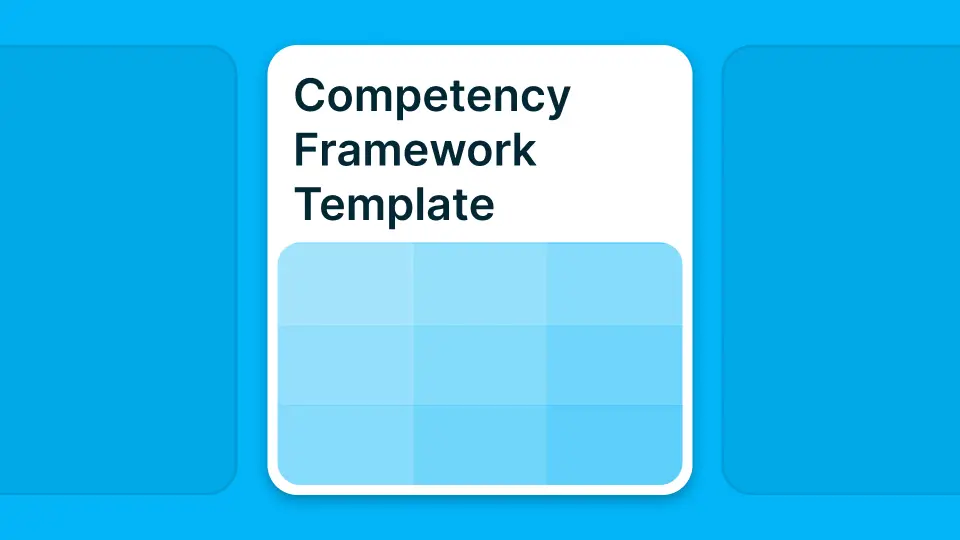The average SaaS spend per employee reached a staggering $9,000–$17,000 annually in 2025 according to TechRadar—and skill management software pricing often hides within that sprawling budget, unnoticed until renewal time. Yet behind every "per-user-per-month" tag lie hidden module premiums, integration fees, and compliance surcharges that can double your real costs. This guide cuts through vendor marketing to reveal what truly drives skill management software pricing: from transparent benchmark ranges across company sizes to negotiation tactics that save you thousands. You'll learn how to calculate genuine total cost of ownership (TCO), spot hidden fees before they bite, and leverage EU/DACH-specific requirements as bargaining chips—not barriers. Whether you're evaluating your first competency platform or renegotiating an existing contract, these insights arm you with the data and playbook to pay fairly and never overspend.
1. Understanding Skill Management Software Pricing Models in 2025
Pricing models for skill management platforms vary wildly—per user per month, modular bundles, admin versus employee seats, or usage-based AI add-ons. Knowing which structure fits your organization can mean thousands in savings each year. Most modern systems arrive as cloud-SaaS solutions with modular architecture: taxonomies, gap analysis, talent marketplaces, and career pathing often carry separate premiums on top of base licenses.
In practice four dominant models shape the market. First, the classic subscription (SaaS) model charges per employee monthly or annually—small vendors start around €5–10 per user while enterprise suites reach €50+ depending on features. TechRadar benchmarks show typical HR platforms range from $5.50 (Sage HR) to $8+ (Rippling) per user monthly for entry tiers. Second, modular versus suite pricing lets buyers pick specific capabilities—base talent management plus optional analytics or mobility modules—with premiums of 10–30% per add-on. Third, some vendors differentiate admin versus end-user licenses: only managers and HR analysts pay full price while rank-and-file staff access lighter features at reduced rates (though pure per-seat models remain more common). Fourth, usage-based extras bill separately for heavy AI analytics or API credits—think predictive skills matching or advanced dashboards charged per query or report volume.
Company size dramatically shifts benchmark ranges. A 50-employee startup selecting core features at €10 per user monthly pays roughly €500–600/month (€6k–7k annually). Scale to 200 employees and volume discounts kick in—perhaps €8/user yields €1,600 monthly (€19k annually). At 500+ seats enterprise negotiations replace public pricing; custom quotes often hover around €6/user or less but bundle implementation and support differently. Large platforms like Workday or SAP SuccessFactors rarely publish list prices—expect five- to six-figure annual commitments once integrations and onboarding land.
- Map user types early: distinguish admins needing full access from end users browsing career paths
- Compare modular options against all-in-one suites—avoid paying for unused modules
- Ask about volume thresholds where per-seat pricing drops (e.g., 200+ or 500+ tiers)
- Identify any usage-based charges: AI analytics credits, API calls, or premium report generation
- Review contract terms for multi-year price locks versus annual escalation clauses
| Company Size | Base Price/User/Month | Analytics Add-On (+20%) | Monthly Total | Annual Total |
|---|---|---|---|---|
| 50 | €10 | €2 | €600 | €7,200 |
| 200 | €8 | €1.60 | €1,920 | €23,040 |
| 500 | Custom (~€6) | ~€1 | ~€3,500 | ~€42,000 |
Some platforms split admin-only licenses from full users—clarify this distinction up front to avoid surprise invoices when half your team only needs read access. Once you grasp how these models work it's time to explore what actually drives those numbers up or down.
2. What Really Drives Skill Management Software Pricing? Module Premiums and Hidden Fees
The true price tag isn't just base licenses—it's premium modules for taxonomies or gap analysis, integration fees, training packages, and support tiers that inflate total spend. Modern skill platforms sell capabilities as separate line items: a core system might include basic competency records while advanced features—32,000+ skills taxonomy databases, AI-powered gap analytics, internal mobility marketplaces, and career pathing—command 10–30% premiums each.
Premium modules typically break down this way: Skills taxonomy (comprehensive ESCO- or O*NET-aligned catalogs) adds €2–4 per user monthly or comes bundled in enterprise tiers. Gap analysis (automated competency assessments and dashboard reporting) usually carries a 10–20% uplift on base licenses. Internal mobility tools (talent marketplaces where employees browse open roles) often land as flat fees—€300–800 monthly regardless of user count—or standalone marketplace subscriptions. Career pathing and succession planning modules can push costs another 5–15%. 360° feedback systems integrated into performance reviews may be standard or charged separately depending on vendor strategy.
A mid-sized tech firm recently selected a base platform at €8 per user for 200 staff—annual license €19,200. Then they added skills taxonomy (+€3/user = +€7,200/year), gap analytics (+15% = +€2,880), and a flat-rate internal mobility marketplace (€500/month = €6,000/year). Their "basic" quote ballooned from €19k to over €35k once add-ons tallied up. Hidden fees lurk beyond modules too: onboarding and training typically cost 25–100% of year-one licenses; many vendors charge separately for HRIS/LMS integrations unless standard connectors exist; premium support packages (24/7 hotlines, dedicated account managers) add another 5–15% annually; some even bill for major version upgrades or early termination.
- Demand an itemized quote detailing each module's premium—not just a bundled total
- Check if onboarding and training are included or extra (often +25–100% first year)
- Investigate recurring integration fees—are HRIS/SSO/LMS connectors standard or custom-priced?
- Watch for "premium support" surcharges (~5–15%/year) versus basic ticket-based help
- Scrutinize upgrade policies—some vendors charge fees for major releases or new features
| Module | Typical Premium Per User | Alternative Fee Model |
|---|---|---|
| Skill Taxonomy | +€2–4/month | Included in enterprise tier |
| Gap Analysis | +10–20% base license | Part of analytics bundle |
| Internal Mobility | Flat fee (€300–800/month) | Standalone marketplace subscription |
| Career Paths & Succession | +5–15% base | Sometimes bundled with performance module |
| 360° Feedback | +€1–3/user or included | Part of performance suite |
Some vendors include basic reporting but charge extra for advanced dashboards or predictive analytics—clarify exactly which reports come standard before signing anything promising "comprehensive analytics." With a clear map of where money goes let's break down how to calculate total ownership costs beyond just licensing fees.
3. Calculating Total Cost of Ownership: Implementation, Integrations, and Data Residency
TCO extends far beyond monthly subscriptions—it includes implementation and onboarding efforts, integrations with HRIS/LMS/SSO systems, data residency charges for EU hosting requirements, ongoing support tiers, and training investments that shape real-world spend over three to five years.
Implementation alone typically equals 25–100% of annual license fees depending on complexity: a 200-person rollout priced at €16k yearly in licenses might require another €8k–12k for workshops, data migration from spreadsheets or legacy systems, configuration of skill frameworks aligned with company roles, initial admin training sessions, and pilot-phase adjustments before full launch. HRIS integrations add further expense—connecting the new platform via APIs or middleware to existing HRIS (SAP SuccessFactors, Workday), payroll systems, learning management platforms (Cornerstone LMS), SSO providers (Azure AD), SCIM provisioning endpoints requires either standard connectors (often free but limited) or custom development billed hourly or as fixed packages (€2k–10k per integration depending on scope). Data residency surcharges apply when GDPR mandates EU-only hosting or German works councils demand domestic servers—vendors typically add 5–10% for certified regional data centers versus global cloud options.
Support tiers range from basic email/ticket channels included in standard subscriptions to premium packages offering phone hotlines, dedicated account managers, guaranteed response times (SLAs), and 24/7 availability—budget an extra 5–15% annually if critical uptime matters for your talent operations. Training and change management costs compound quickly: system admin bootcamps, HR business partner workshops, manager onboarding sessions, end-user communication campaigns can easily consume another €5k–15k depending on organization size and readiness for digital transformation initiatives focused on skills transparency.
Consider a realistic scenario: A financial services provider with 200 employees chose licenses at €16k/year but underestimated data residency surcharges when insisting on EU-only hosting (+5% = +€800), underestimated integration complexity connecting their legacy HRIS (+€3k one-time setup), underestimated premium support needs to satisfy compliance audits (+10% annually = +€1.6k), then added change management workshops post-launch (+€5k). Their year-one TCO landed around €34k—more than double the sticker price.
- List every anticipated integration point—ask if connectors are standard or custom-priced up front
- Budget realistically for onboarding; complex migrations from Excel or older systems mean higher upfront fees
- Factor in compliance/data storage surcharges if EU/Germany-only hosting required for GDPR/works council approval
- Decide standard versus premium support—set aside up to 15% extra annually if critical SLAs needed for audit readiness
- Account for training and change management sessions post-launch—don't assume adoption happens organically without investment in communication campaigns
| Cost Component | Example Value (200 employees) |
|---|---|
| Annual Licenses | €16,000 |
| Implementation & Onboarding | €10,000 |
| Integrations (HRIS/SSO/LMS) | €3,000 |
| Data Residency Surcharge (EU-only hosting) | €800 |
| Support & Training (premium tier + workshops) | €2,400 |
| Year-One Total | €32,200 |
Create two scenarios in your TCO calculator—"Minimal Solution" covering core features only versus "Full Suite" including all modules—to compare apples-to-apples across competing vendors during RFP evaluation rounds. Now that you have a complete TCO picture how do you negotiate the best deal while protecting your interests contractually?
4. The Negotiation Playbook: Pilots, Ramp Pricing, Multi-Year Discounts, and GDPR Clauses
Smart buyers move beyond list prices to negotiate pilot projects with discounted scope, ramped rollouts that scale pricing linearly as headcount grows, multi-year commitments securing 10–30% annual discounts—and they demand clear GDPR/data ownership clauses plus vendor accountability via SLAs backed by service credits for missed uptime targets.
Multi-year contracts remain one of the strongest levers: vendors typically offer at least 10% off annual fees for two- or three-year commitments—some extend this to 20% or more if you lock in longer terms—because predictable recurring revenue matters immensely in SaaS economics. Pilot projects de-risk initial investment by limiting scope to one department or business unit (50–100 users) before company-wide rollout; negotiate pilot-specific discounts or flexible exit clauses so you aren't locked into full deployment if results disappoint during proof-of-concept phase. Ramped rollout pricing scales costs proportionally as user counts grow rather than imposing stepwise jumps—insist on linear pricing adjustments tied to actual employee numbers rather than rigid tier thresholds that penalize organic growth.
EU buyers must address GDPR/DPA specifics early: demand a signed Data Processing Agreement (DPA) meeting Article 28 GDPR requirements before finalizing contracts; clarify data ownership rights so you retain full control over competency records if switching vendors later; specify data export formats (CSV, JSON, API access) and retention policies post-termination so migrating away remains feasible without vendor lock-in traps. Works council involvement matters critically in Germany/Austria—schedule joint workshops with Betriebsrat representatives during vendor evaluation stages so they co-design anonymization settings and reporting rules ensuring compliance with §87 BetrVG co-determination rights rather than derailing launch after contracts sign.
A European media group recently started with a department pilot covering 50 staff—negotiated ramped pricing as they scaled full rollout over two years instead of paying enterprise rates immediately—with clear exit clauses tied to quarterly performance reviews and service credits written into SLA agreements guaranteeing >99.5% uptime with financial penalties if missed (e.g., one month's fees credited back per outage exceeding thresholds). They secured a 15% discount by committing three years up front while retaining flexibility to terminate after year two if adoption metrics fell below agreed KPIs.
- Start with pilot scope before committing company-wide—request discounted pilot licenses or flexible phased rollout terms
- Ask about ramp/prorated pricing as headcount grows—push back against stepwise tier jumps that penalize scaling smoothly over time
- Push for multi-year discount rates targeting ≥10%—request written quotes comparing annual versus three-year total costs side-by-side
- Insist on GDPR-compliant DPA addendum meeting Article 28 standards—clarify data exit/export rights explicitly upfront before signing anything binding
- Make service credits part of SLA if uptime/support targets missed—specify financial remedies (fee credits) tied directly to measurable KPIs like availability or response times
| Negotiation Item | Best Practice |
|---|---|
| Pilot Project | Yes—discounted rate, flexible scope, clear success criteria |
| Ramp Pricing | Linear scale-up preferred over stepwise tiers |
| Multi-Year Discount | ≥10%, request written quote comparing annual vs. multi-year total costs |
| GDPR DPA Addendum | Vendor-signed agreement meeting Article 28 GDPR requirements |
| Service Credits | Financial remedies (fee credits) tied to uptime/SLA targets |
| Data Exit Rights | Specify export formats (CSV/JSON/API) and retention policies post-termination |
Prepare a redlines checklist covering privacy/ownership/SLA terms before final contract review—flag clauses granting vendors broad rights to use anonymized data for product improvement without explicit consent or imposing steep early termination fees designed to lock you in indefinitely. For organizations in the EU/DACH region there are extra legal hoops—let's see what makes their requirements unique beyond standard GDPR compliance measures.
5. EU and DACH Specifics: Privacy-by-Design, Works Council Consultation, and Data Residency Requirements
In Europe—especially Germany—the introduction of skills platforms triggers strict privacy laws under GDPR and works council co-determination rights under BetrVG; neglecting these can derail even technically perfect projects through legal challenges or employee resistance rooted in transparency concerns about competency monitoring systems perceived as surveillance tools rather than development enablers.
GDPR mandates privacy-by-design principles: platforms must implement encryption at rest (data stored encrypted), pseudonymization where feasible (replacing identifiable employee names with codes in analytics dashboards), role-based access controls limiting who sees what sensitive information, audit logs tracking every system action on personal data records. Germany's Betriebsverfassungsgesetz (Works Constitution Act) §87 Abs.1 Nr.6 requires works councils (Betriebsrat) to approve any technical system used for monitoring employee behavior or performance—nearly all German companies need formal consultation before launching competency platforms because skill assessments could theoretically enable performance tracking (DataAgenda). Austria follows similar patterns under Arbeitsverfassungsgesetz rules governing employee participation rights when introducing digital HR tools affecting working conditions or career prospects.
Data residency demands add cost but offer competitive advantage: many European enterprises require EU-only hosting guarantees ensuring personal data never leaves European Economic Area boundaries—vendors typically charge 5–10% premium for certified regional data centers versus default global cloud infrastructure spread across multiple continents including non-EU jurisdictions lacking adequate GDPR protections under Commission adequacy decisions. This matters because GDPR Article 44-49 restrict international transfers unless recipients meet strict safeguards—post-Schrems II ruling invalidating Privacy Shield agreements with USA many German firms insist on German-hosted solutions exclusively avoiding transatlantic data flows entirely.
An automotive supplier in Munich involved its Betriebsrat from day one when rolling out new competency platform—co-designing anonymization settings ensuring aggregated skills reports showed department-level gaps without exposing individual employees' weaknesses publicly—and negotiated a Betriebsvereinbarung (works agreement) codifying access controls (managers see team skills only; HR sees broader analytics but cannot drill down into individual assessment scores without explicit consent). This proactive engagement avoided six-month delays common when works councils discover planned implementations late triggering veto rights under co-determination statutes protecting worker privacy interests against employer overreach into personal development records treated as sensitive employment data equivalent to performance evaluations legally.
- Consult legal and privacy experts early if operating in EU/DACH countries—don't wait until contract signing stage to discover compliance gaps requiring expensive rework
- Confirm vendor supports EU-only hosting/data residency options explicitly—request documentation proving data center locations meet GDPR Article 44-49 transfer requirements without relying on invalidated frameworks like Privacy Shield
- Document privacy-by-design measures (encryption at rest/in transit, pseudonymization capabilities, role-based access controls) clearly in RFP responses so vendors demonstrate compliance upfront rather than promising vague "GDPR compliance" without technical specifics backing claims
- Engage works councils proactively—schedule joint workshops during vendor evaluation involving Betriebsrat representatives in process design discussions co-creating anonymization rules and reporting boundaries ensuring transparency meets employee protection standards under BetrVG §87
- Clarify reporting/anonymity settings to comply with local labor law—balance business intelligence needs against individual privacy rights through aggregated dashboards masking personal identifiers where legally required under national data protection statutes stricter than baseline GDPR minimums
| Requirement | Action Needed |
|---|---|
| GDPR-compliant DPA | Vendor-signed addendum meeting Article 28 standards |
| Data-at-Rest Encryption | Enforced by default with documented key management policies |
| EU-Only Hosting (Data Residency) | Contractual guarantee servers remain within EEA boundaries only |
| Works Council Consultation* | Early engagement via joint workshops co-designing access/reporting rules |
| Privacy-by-Design Documentation | Detailed technical specs proving pseudonymization/audit capabilities built-in |
*Mandatory in Germany/Austria under BetrVG/ArbVG co-determination statutes
A strong privacy/compliance story becomes competitive advantage when pitching change internally—position your skills initiative as "employee-first development platform respecting data rights" rather than "top-down monitoring system" framing that triggers resistance from works councils and staff alike based on surveillance fears rooted in past performance management abuses common before modern privacy regulations imposed strict boundaries protecting worker dignity interests against intrusive employer control over personal career information treated as fundamental rights under European social market economy values embedded in labor law traditions across DACH region. Now let's make sure you're fully prepared with buyer-ready artifacts keeping surprises at bay during procurement and implementation phases.
6. Buyer Readiness Toolkit: Cost Tables, Redlines Checklists, and Vendor Questionnaires
Coming to negotiation tables armed with detailed cost breakdowns—and tough vendor questionnaires probing integration complexity, reporting flexibility, future scalability roadmaps—is the best way to avoid costly missteps or lock-in traps common when buyers rely solely on sales presentations emphasizing features over total financial impact across multi-year contracts binding organizations to platforms misaligned with evolving talent strategies.
Redlines checklists flag hidden risks lurking in standard SaaS contracts: clauses granting vendors perpetual rights to use anonymized customer data for product development without compensation; automatic renewal terms locking buyers into another year if cancellation notices miss narrow windows 90+ days before contract end; steep early termination fees calculated as remaining contract value discouraging exits despite poor performance outcomes; vague SLA definitions allowing vendors to escape accountability through "best efforts" language lacking measurable uptime guarantees or response time commitments. Sample TCO tables enable apples-to-apples comparison across providers by standardizing line items—base licenses, module premiums, implementation fees, integrations, support tiers, training packages—revealing which vendors hide costs in ambiguous "professional services" buckets versus transparent itemized pricing models respecting buyer intelligence.
Companies using structured RFPs with comprehensive vendor questionnaires report fewer surprise costs post-contract according to TechRadar research—because forcing vendors to specify exactly which reports come standard versus premium analytics tiers, exactly which integrations require custom development versus pre-built connectors, exactly which data export formats ensure portability if switching platforms later creates accountability preventing sales teams from overpromising capabilities during demos that disappoint after implementation when reality diverges from polished proof-of-concept environments tailored for maximum impression during evaluation phases.
An international retailer used an internal spreadsheet template listing every anticipated line-item—admin seat counts, end-user licenses, skills taxonomy module costs, gap analytics fees, internal mobility marketplace charges, SSO integration setup, HRIS connector expenses, premium support annual costs, onboarding workshop fees, change management consulting hours—to compare three finalist platforms side-by-side before shortlisting. This transparency revealed one vendor's "competitive" base pricing actually exceeded competitors once all required add-ons tallied up while another's higher sticker price included comprehensive bundles reducing TCO by 15% over three years making them clear winner despite initial appearance of premium positioning.
- Build comprehensive cost table including ALL direct/indirect expenses—don't accept vendor summaries omitting inconvenient details about extra fees discovered only after signing contracts binding you legally
- Draft redlines checklist covering privacy/SLA/data export clauses before negotiations start—identify non-negotiable requirements (EU hosting, service credits, clear exit paths) flagging deal-breakers early rather than discovering them buried in fine print after legal reviews consume weeks delaying procurement timelines unnecessarily
- Prepare vendor questions focused on integrations/reporting/future scalability—not just current features demonstrated during polished sales presentations—asking specifically: "Which HRIS platforms connect via pre-built APIs versus custom development?" "Can we export all data including historical records in CSV/JSON formats?" "How do pricing tiers adjust if we grow from 200 to 500 employees mid-contract?"
- Include success criteria and measurable KPIs in RFP so outcomes become contractually binding through SLA provisions—specify adoption rates (e.g., 70% active users within six months), engagement metrics (monthly logins, skills updates), business impact targets (internal hire percentages, time-to-fill reductions) making vendor accountable for delivering value beyond software licenses alone
- Request sample contracts or SLA documents during selection—review actual legal language governing relationships rather than relying on verbal assurances from sales teams lacking authority to bind companies contractually once deals close and account management transitions from acquisition-focused sellers to retention-focused support teams operating under different incentive structures
| Cost Item | Vendor A | Vendor B | Vendor C |
|---|---|---|---|
| Base Licenses (200 users) | |||
| Analytics Module Premium | |||
| Onboarding & Implementation | |||
| Integrations (HRIS/SSO/LMS) | |||
| Support Tier (Standard/Premium) | |||
| Training & Change Management | |||
| Year-One Total | |||
| Three-Year Total (with discounts) |
Use this structured comparison framework during RFP evaluation phases to benchmark competing proposals objectively rather than subjectively based on demo polish or sales rapport—because procurement decisions made without rigorous financial analysis often lead to regret cycles where organizations either overpay for underutilized features or underpay for inadequate platforms requiring expensive replacements within 18–24 months wasting both initial investments and opportunity costs from delayed talent development initiatives critical for competitive advantage in tight labor markets characterized by accelerating skills obsolescence driven by AI/automation transformations reshaping work fundamentally across industries. With your toolkit ready and pitfalls mapped out you're set for confident decision-making navigating skill management software pricing complexities successfully.
Conclusion: Benchmark Smarter and Negotiate Better on Skill Management Software Pricing
Skill management software pricing goes far beyond sticker prices—hidden module premiums for taxonomies and analytics, integration expenses connecting HRIS/LMS systems, support tier upgrades ensuring adequate SLAs, data residency surcharges meeting EU compliance demands matter just as much as core per-user license fees when calculating true total cost of ownership over multi-year contracts binding organizations to platforms shaping talent strategies fundamentally.
Calculating total cost means factoring in onboarding workshops, data migration complexity, GDPR-compliant hosting requirements, change management investments—not just monthly subscription fees—and negotiating pilots with flexible exit clauses, ramped rollout pricing scaling linearly with headcount growth, multi-year commitments securing 10–30% discounts becomes essential for savings while protecting your interests through clear DPA agreements, service credits backing SLA guarantees, data export rights ensuring portability if switching vendors later without facing lock-in traps designed to maximize vendor leverage at renewal negotiations when switching costs peak creating asymmetric bargaining power favoring incumbents over challengers.
In regulated markets like EU/DACH regions involving legal experts and privacy teams plus works councils from day one avoids implementation delays common when Betriebsrat discovers planned systems late triggering veto rights under co-determination statutes—proactive engagement co-designing anonymization rules and reporting boundaries turns potential obstacles into allies championing platforms respecting employee data rights while delivering business intelligence needs balancing transparency against privacy protections required under GDPR Article 5 principles limiting processing to necessary purposes specified explicitly upfront rather than permitting broad surveillance capabilities exceeding legitimate talent development objectives justifying competency data collection legally.
Next steps for readers: Map your current processes identifying user groups (admins versus end users), required modules (taxonomy, gap analysis, mobility tools), integration points (existing HRIS/LMS/SSO systems) before requesting quotes—this preparation enables accurate vendor comparisons rather than reactive decisions based on incomplete information during rushed procurement timelines. Build detailed TCO calculator including every likely expense scenario (minimal solution versus full suite) for objective evaluation across competing platforms using standardized cost breakdowns revealing true multi-year financial impact. Prepare negotiation checklists covering redlines on privacy clauses, SLA terms, data ownership rights, exit provisions so you control contract risks proactively rather than accepting vendor-favorable terms drafted protecting their interests primarily over yours as customer bearing implementation risks and opportunity costs if platforms underdeliver against promised capabilities demonstrated during polished sales cycles disconnected from post-contract operational realities.
Looking ahead skill intelligence will soon underpin nearly every aspect of talent strategy worldwide—recruiting, development, succession planning, workforce planning, internal mobility—as AI-driven automation reshapes jobs faster than traditional learning cycles adapt leaving organizations dependent on real-time competency visibility distinguishing winners from losers competing for scarce talent in markets where skills obsolescence accelerates continuously. Regulatory pressure mounts alongside innovation: EU proposals for mandatory upskilling rights, expanded works council oversight of AI-based HR systems, stricter enforcement of GDPR privacy violations all raise compliance stakes while simultaneously creating differentiation opportunities for platforms architected around privacy-by-design principles respecting worker dignity interests embedded in European social market traditions governing employment relationships fundamentally differently than Anglo-American shareholder capitalism models prioritizing efficiency over equity considerations shaping product roadmaps accordingly. Only companies mastering both cost control through rigorous TCO analysis negotiating favorable terms AND compliance excellence embedding GDPR/BetrVG requirements into vendor selection criteria from inception rather than afterthoughts discovered post-contract will thrive converting skills transparency from administrative burden into strategic advantage powering talent outcomes measurably superior to competitors still operating blind without competency intelligence systems illuminating workforce capabilities gaps opportunities guiding investments optimally across learning development recruiting retention initiatives maximizing returns on human capital deployed strategically toward organizational objectives aligned clearly with individual career aspirations creating win-win scenarios sustaining engagement motivation performance excellence over long horizons required for compounding returns on people investments paying dividends perpetually unlike transactional hiring approaches treating talent as commoditized inputs rather than differentiated assets worth cultivating systematically through intentional development pathways supported by modern platforms priced fairly transparently accountably.
Frequently Asked Questions (FAQ)
What are the main factors driving skill management software pricing in 2025?
Core drivers include number of users and licenses required; choice of modules such as advanced analytics, career path tools, internal mobility marketplaces; support level selected ranging from basic ticket systems to premium 24/7 hotlines with dedicated account managers; integrations needed connecting HRIS, LMS, SSO, payroll systems via standard APIs versus custom development; data residency demands requiring EU-only hosting for GDPR compliance; onboarding and training services including workshops, change management consulting, admin bootcamps; plus any usage-based AI add-ons charged separately for predictive analytics, skills matching algorithms, or premium reporting features beyond standard dashboards. Small companies might pay €5–10 per user monthly while enterprises negotiate custom quotes often exceeding €50 per user depending on complexity and scale—but module premiums (typically 10–30% per add-on) and hidden implementation fees (25–100% of annual licenses) often double sticker prices making TCO analysis essential for accurate budget planning across multi-year contracts.
How do typical price ranges differ between small businesses and enterprises for skill management platforms?
Small businesses with fewer than 200 employees usually pay around €5–15 per user per month depending on features chosen—basic competency tracking with self-assessments and simple reporting lands at lower end while comprehensive suites including gap analytics, career pathing, internal mobility tools push toward upper range. Midsize firms (200–500 employees) often receive volume discounts reducing per-seat costs to €6–10 monthly as economies of scale kick in rewarding larger commitments. Enterprises with 500+ employees typically negotiate custom quotes rarely published publicly—annual contracts commonly exceed €50 per user monthly when highly tailored solutions, dedicated support teams, extensive integrations, compliance requirements (EU data residency, works council approval processes), and multi-tenancy configurations supporting global operations across regions with different regulatory frameworks all factor into pricing models designed individually rather than following standardized rate cards applicable to smaller deployments with simpler needs.
Are there hidden fees I should watch out for when evaluating skill management software vendors?
Yes—common hidden costs include implementation and onboarding fees equal to up to one year's license price covering workshops, data migration from spreadsheets or legacy systems, configuration of skill frameworks aligned with company roles, initial training sessions; extra charges for premium support tier upgrades offering phone hotlines, dedicated account managers, guaranteed SLA response times, 24/7 availability beyond basic email/ticket systems included in standard subscriptions; integration setup costs beyond pre-built connectors when custom development required linking HRIS, LMS, SSO systems via APIs or middleware (€2k–10k per integration depending on scope); training and change management workshops post-launch helping drive adoption through communication campaigns, manager coaching, end-user bootcamps (€5k–15k depending on organization size); sometimes even charges for major version upgrades or new feature releases not included in maintenance agreements; early termination fees calculated as remaining contract value discouraging exits despite poor performance outcomes; data residency surcharges (+5–10%) when EU-only hosting required for GDPR compliance or works council approval in Germany/Austria. Demand itemized quotes detailing every potential cost upfront before signing contracts—transparency during procurement prevents expensive surprises later when budgets already committed leaving no flexibility renegotiating better terms retroactively.
How can I estimate fair admin versus end-user seat ratios when budgeting for skill management licenses?
Industry practice suggests roughly 10–20% admin or manager seats requiring full access rights (system configuration, reporting dashboards, analytics tools, user management capabilities) versus about 80–90% standard user seats per organization where employees primarily update their own skill profiles, browse career paths, view personalized learning recommendations without needing advanced administrative functions—but always confirm if your vendor bills differently or allows flexible assignment based on actual roles and responsibilities rather than imposing rigid ratios penalizing organizational structures deviating from their assumptions. Some platforms charge premium rates only for power users (HR analysts, talent managers) while offering discounted or free basic access for rank-and-file staff—this tiered model can reduce total costs significantly compared to flat per-seat pricing treating all users identically regardless of feature utilization patterns varying widely across populations where most employees engage lightly with self-service tools while small cohorts drive heavy usage through administrative workflows requiring sophisticated capabilities justifying higher license fees economically.
What steps should I take to accurately calculate total cost of ownership before signing a skill management software contract?
List every needed module and user group first identifying core requirements versus nice-to-have extras—distinguish admin seats from end users, specify which premium features (gap analytics, internal mobility, career pathing, 360° feedback) matter versus standard capabilities sufficient initially. Request itemized quotes from vendors showing all extras including integration costs (HRIS/SSO/LMS connectors), support levels (standard ticket systems versus premium packages with SLAs), onboarding fees (workshops, data migration, configuration), training investments (admin bootcamps, manager coaching, change management consulting)—don't accept summary totals obscuring where money goes making comparisons difficult across competing proposals. Estimate realistic implementation timelines and costs accounting for internal resources (project managers, IT support, change champions) plus external consultants if complex migrations from legacy systems or integrations with customized HRIS platforms require specialized expertise unavailable in-house. Include ongoing maintenance and support needs budgeting 5–15% additional annually if premium SLAs critical for compliance audits or business continuity during peak talent cycles (year-end reviews, annual planning). Factor in currency exchange rate impacts plus local taxes (VAT in EU) where applicable ensuring apples-to-apples comparisons when evaluating international vendors billing different currencies. Create two scenarios—minimal solution covering essentials only versus full suite including all modules—then multiply by employee count projections (current headcount plus anticipated growth over contract term) revealing total multi-year financial commitment required making informed decisions possible based on complete pictures rather than misleading base prices masking true costs discovered only after contracts signed and implementation underway with no flexibility renegotiating terms retroactively once legally bound.












